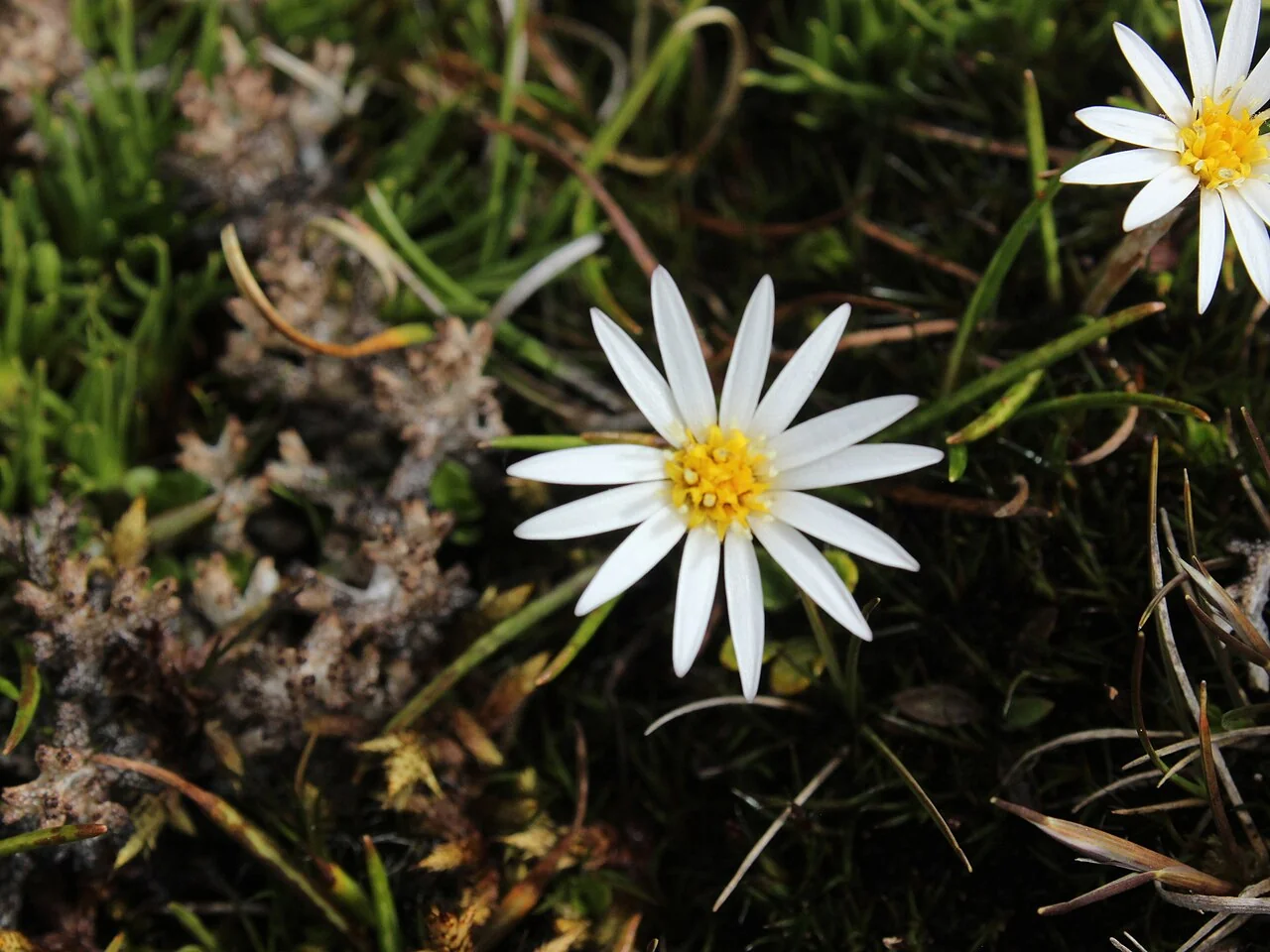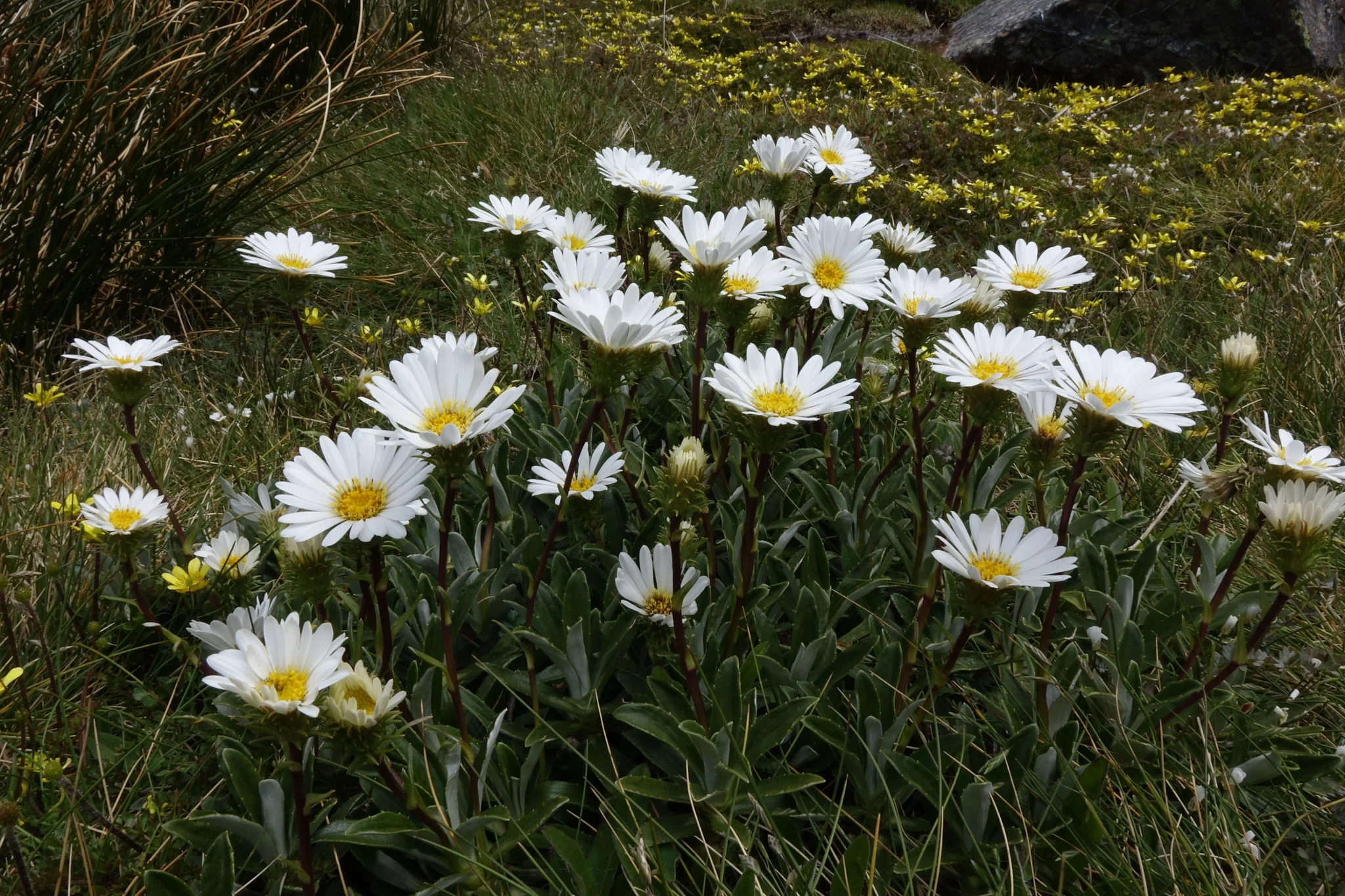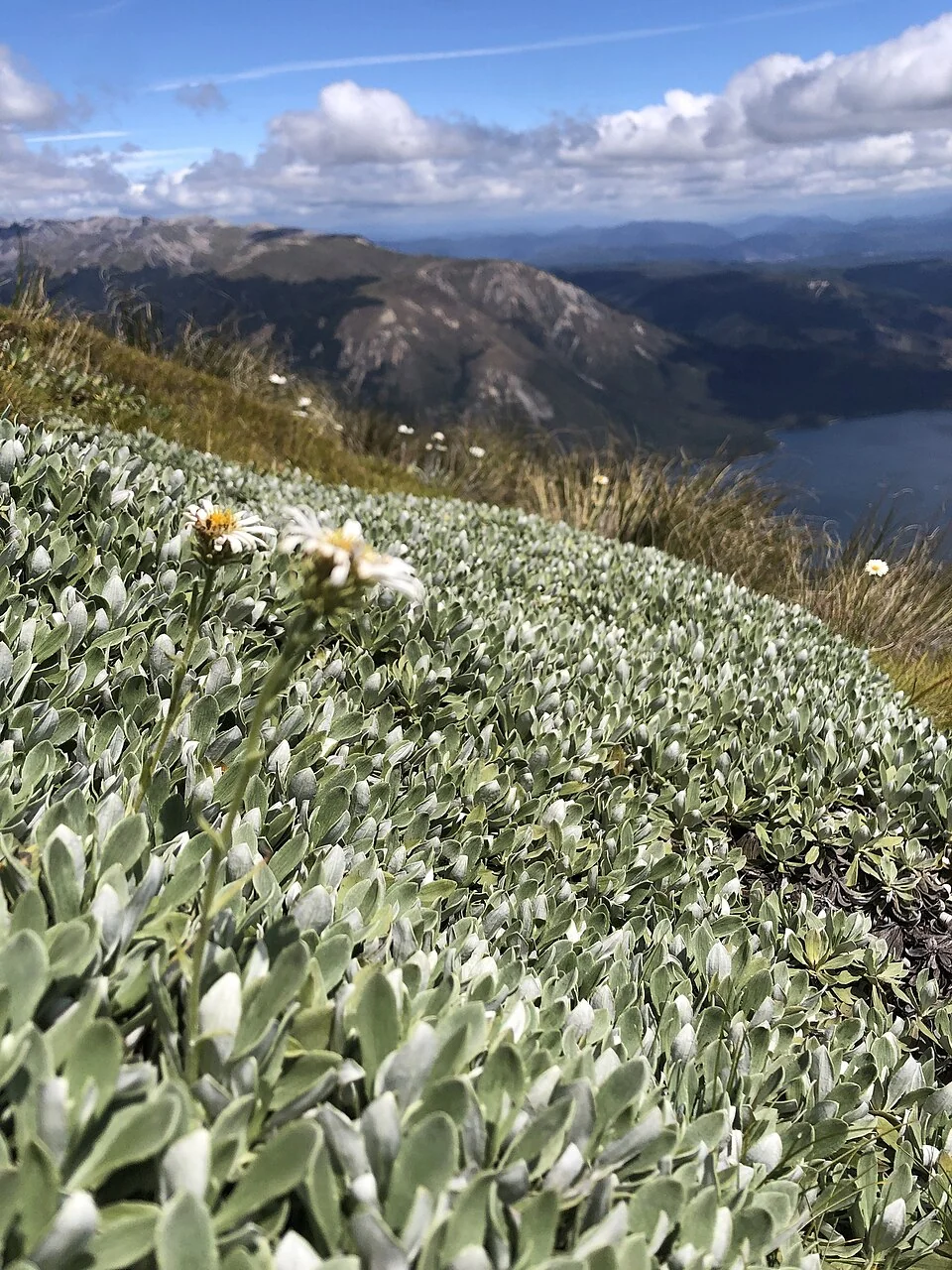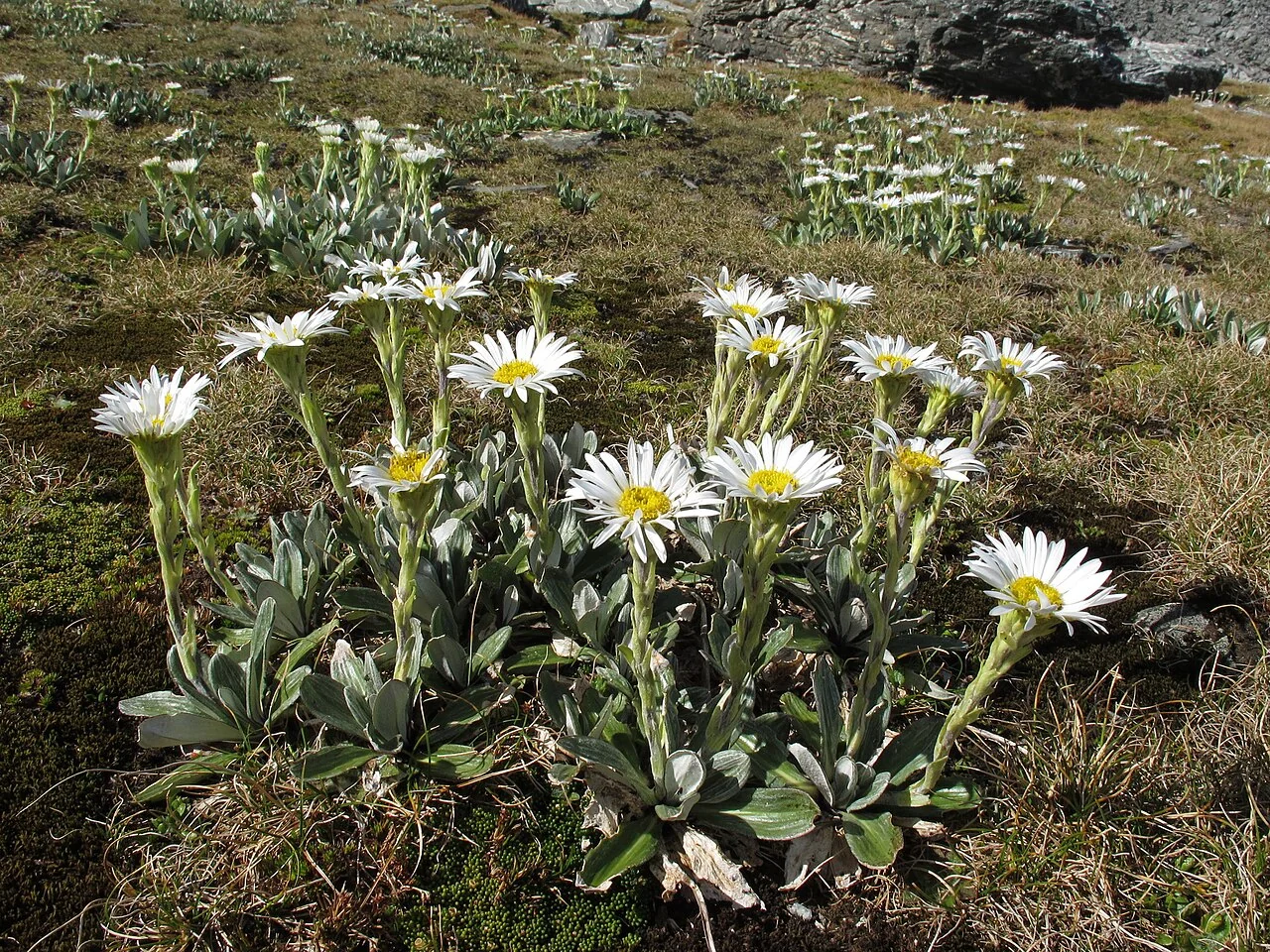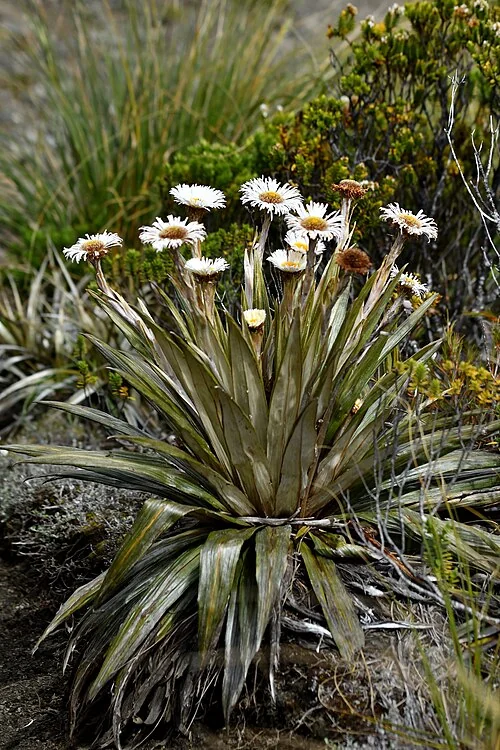
Leather-Leaved Daisy
Celmisia coriacea
Explore more NZ native plant guides in our index .
Introduction
About Leather-Leaved Daisy
Celmisia coriacea , commonly known as Leather-leaved Daisy or Tikumu, is a striking perennial herb native to the alpine and subalpine regions of New Zealand. It forms large, robust rosettes of stiff, leathery, sword-shaped leaves that are typically silvery-green with a distinctive orange stripe down the midrib. In summer, it produces large, white, daisy-like flowers on tall stalks. This hardy plant is highly valued for its dramatic foliage and is a prominent feature of alpine landscapes.

Plant Description
Celmisia coriacea , commonly known as Leather-leaved Daisy or Tikumu, is a robust, woody-based perennial herb native to the alpine and subalpine regions of New Zealand's South Island. It forms large rosettes of stiff, leathery, sword-shaped leaves, typically silvery-green with a distinctive orange stripe down the midrib. The undersides of the leaves are densely covered in glistening, silvery hairs. In summer, it produces large, showy white daisy-like flowers with golden discs, held above the foliage on stout stalks. This alpine specialist thrives in permanently moist, free-draining, acidic soils and is highly tolerant of frost and strong winds.
Quick Facts
Alpine Plant Summary
| Scientific Name | Celmisia Coriacea |
|---|---|
| Height | 30-60 cm |
| Spread | 30-50 cm |
| Water Needs | Low; prefers well-drained soil |
| Light | Full sun |
| Frost Tolerance | Very high |
| Salt Tolerance | Low |
| Growth Rate | Slow |
| Lifespan | Perennial |
Climate Best Suited to
Celmisia coriacea is found in the alpine and subalpine zones of the South Island of New Zealand. It thrives in cool, exposed environments with good drainage and is highly tolerant of frost and strong winds.
Regional Suitability
| Whangārei | Ideal |
| Auckland | Ideal |
| Hamilton | Suitable |
| Rotorua | Suitable |
| Tauranga | Ideal |
| Gisborne | Ideal |
| New Plymouth | Ideal |
| Whanganui | Ideal |
| Palmerston North | Suitable |
| Napier | Ideal |
| Wellington | Ideal |
| Nelson | Ideal |
| Christchurch | Suitable |
| Dunedin | Suitable |
| Invercargill | Suitable |
| City | Climate Suitability |
|---|
Habitat
Natural Distribution
Celmisia coriacea , also known as Leather-leaved Daisy or Tikumu, is endemic to the South Island of New Zealand, primarily found in Fiordland and western Southland. Its natural habitat is montane to alpine regions, typically near the timberline.
It is a common component of wet grassland and herbfield ecosystems, where it forms large patches in boggy grass-rush communities interspersed with low scrub. This plant thrives in cool, moist alpine and montane conditions with excellent drainage, requiring permanently moist, free-draining, acidic soil. It prefers shaded locations with protection from intense heat and good air circulation, and cannot tolerate drying out. Its specialized adaptations allow it to flourish in these challenging high-altitude environments.
Plant Conservation
Conservation Status
Celmisia coriacea is currently classified as "Not Threatened" according to the New Zealand Threat Classification System, reflecting its relatively secure status across its natural range in the South Island's mountainous regions. This alpine specialist is found in various high-altitude habitats including alpine grasslands, herb fields, rocky slopes, and subalpine scrublands from Canterbury to Fiordland.
Despite its stable conservation status, the species faces ongoing pressures typical of alpine plants, including climate change impacts, habitat modification from introduced mammals, and potential changes to alpine hydrology. The species' specialized habitat requirements and slow growth rates make it vulnerable to environmental changes, particularly warming temperatures that could shift suitable habitat ranges to higher elevations.
Conservation efforts focus on protecting alpine ecosystem integrity, controlling introduced browsing animals, and monitoring population responses to climate change. The species' importance in traditional Māori culture and its role as an indicator of alpine ecosystem health make its conservation significant for both biodiversity and cultural heritage preservation. Cultivation in specialized alpine collections helps preserve genetic diversity and provides opportunities for research into climate adaptation strategies.
Growing Requirements
Soil Requirements
Prefers very well-drained, gritty, and low-fertility soil. It will not tolerate wet or humid conditions.
Light Requirements
Must have full sun to thrive.
Water Requirements
Extremely drought-tolerant once established. Water sparingly, if at all.
Planting Guide
-
When to Plant
Plant in autumn or spring.
-
Site Preparation
Choose a sunny, very well-drained site.
-
Planting and Aftercare
Dig a hole twice the width of the pot. Add plenty of grit to the planting hole to improve drainage. Place the plant in the hole and backfill with soil. Water well.
Ecological Significance
Celmisia coriacea , commonly known as Leather-leaved Daisy or Tikumu, holds ecological significance primarily through its role as a prominent and endemic component of specific montane and alpine ecosystems in New Zealand's South Island.
- Habitat Formation: It is a common feature of wet grasslands and herbfields, particularly near the timberline. It forms extensive patches within boggy grass-rush communities, often intermixed with low scrub, contributing to the structure and composition of these high-altitude environments.
- Endemic Species: As an endemic taxon to New Zealand, its presence is integral to the unique biodiversity of the Fiordland region and western Southland, representing a specialized evolutionary lineage.
- Wind Dispersal: The plant's pappate cypselae (seeds) are dispersed by wind, indicating an effective mechanism for colonization and maintenance of its populations across suitable habitats in the open alpine environment.
- Contribution to Alpine Flora: The genus Celmisia as a whole is a characteristic and important part of New Zealand's alpine communities, with multiple species often co-occurring. Celmisia coriacea contributes to this rich alpine flora, and its distinctive silver foliage adds to the aesthetic and structural diversity of these landscapes.
- Cultural Significance: Historically, Celmisia coriacea held cultural significance for Māori, who called it "tikumu." Its white, fluffy leaf material was used to make waterproof clothing (pā keka), protective garments (Poho-taupā, tāupā, tahau-taupā), as a tobacco substitute, and for dressing wounds, highlighting its traditional utility and cultural value.
Uses and Significance
Garden Uses
- An excellent plant for rock gardens, scree gardens, and alpine troughs.
- Its dramatic foliage and large white flowers make it a stunning addition to any alpine-themed landscape.
Cultural Significance
Traditional Uses and Values
Leather-leaved Daisy, or Tikumu ( Celmisia coriacea ), holds significant cultural importance for Māori. The white, fluffy undersides of its leaves were traditionally used to make waterproof clothing, such as pā keka (raincapes), and protective garments. It was also used as a tobacco substitute and for dressing wounds, highlighting its versatility and value in traditional Māori life and medicine.
Landscaping Uses
Garden Design Applications
Celmisia coriacea , commonly known as Leather-leaved Daisy, is a striking perennial herb with several valuable landscaping applications, particularly suited for specific alpine and cool-climate garden designs.
- Alpine and Rock Gardens: It is an excellent choice for alpine and high-altitude rock gardens, scree beds, and raised planters. Its preference for free-draining, gritty soils and cool, moist conditions makes it ideal for these specialized environments.
- Bog and Wetland Plantings: The plant thrives in cool climate bog gardens and wetland areas, requiring permanently moist, acidic soil with excellent drainage. This makes it a unique addition to water-feature landscapes.
- Container Gardening: Celmisia coriacea can be grown in specialized containers, making it suitable for alpine plant enthusiasts and for exhibition purposes, allowing its dramatic foliage to be showcased.
- Native and Conservation Gardens: It is often used in native plant collections, botanical gardens, and conservation gardens, especially for endemic South Island species, contributing to the preservation of New Zealand's unique flora.
- Architectural Planting: Its robust form, stiff, leathery, sword-shaped leaves, and large white flowers provide strong architectural interest, making it suitable for architectural planting in city and courtyard gardens that can replicate its cool, moist conditions.
- Woodland Gardens: Larger species of Celmisia , including C. coriacea , can be spectacular subjects for woodland gardens and peat beds, adding a distinctive alpine touch to shaded areas.
Successful cultivation of Celmisia coriacea in landscaping requires attention to its specific needs: it thrives in cool, moist alpine and montane environments, is intolerant of heavy shade and high humidity, and requires permanently moist, free-draining, acidic soil. Consistent moisture is crucial, but excellent drainage is equally important to prevent root rot. It benefits from good airflow and is wind and frost hardy.
Seasonal Care Calendar
Spring
- As new growth emerges, ensure adequate moisture, especially after winter dormancy. Monitor for any signs of fungal issues and ensure good air circulation.
Summer
- Maintain consistently moist soil, as this alpine species dislikes drying out. Protect from intense afternoon sun in warmer lowland areas, and ensure good air movement.
Autumn
- Reduce watering frequency as temperatures cool, but ensure soil remains moist. Remove any spent flower stalks or yellowing leaves to maintain tidiness and prevent disease.
Winter
- Ensure excellent drainage to prevent crown rot, especially during periods of heavy rainfall. Protect from extreme freezes in colder climates, though it is generally hardy.
Pruning and Maintenance
Minimal Care
Remove any old, damaged, or yellowing leaves as needed to maintain the plant's distinctive appearance. This Fiordland endemic requires careful handling due to its vulnerability to sudden death from fungal diseases. Ensure good drainage and avoid disturbing the root system unnecessarily, as these alpine specialists are sensitive to environmental changes and prefer stable growing conditions.
How to Grow Leather-leaved Daisy
From Seeds
Seed propagation of Leather-leaved Daisy represents one of the most challenging endeavors in New Zealand alpine plant cultivation, requiring specialized techniques that replicate the extreme environmental conditions of this species' native Fiordland mountain habitat. This magnificent alpine endemic produces viable seeds only under optimal conditions and demands precise environmental control throughout the entire propagation process, making it suitable primarily for experienced alpine plant specialists and dedicated botanical enthusiasts. The species' natural habitat in the harsh alpine and subalpine zones of the South Island creates seeds that are adapted to extreme cold stratification periods, intense UV exposure, and dramatic temperature fluctuations that are difficult to replicate in cultivation. Collect fresh seeds immediately upon ripening from the large white daisy flowers, typically during late summer to early autumn when seed heads have fully developed but not yet begun natural dispersal, as seed viability decreases rapidly with age in this alpine specialist. Seeds require immediate processing or specialized storage conditions, as they lose viability quickly when exposed to warm or humid conditions that are completely foreign to their alpine origins. Implement extended cold stratification periods of 3-6 months at temperatures between 1-4°C to break the complex dormancy mechanisms evolved for survival in harsh mountain environments, using moist sand or sterile vermiculite as stratification medium. Prepare specialized alpine growing medium that replicates the gritty, extremely well-draining, low-fertility conditions of high-altitude scree slopes, using a combination of coarse sand, fine gravel, perlite, and minimal organic matter to create the harsh growing conditions this species demands. Surface-sow stratified seeds on the prepared medium without covering, as they require light for germination while needing protection from fungal diseases that can quickly destroy emerging seedlings in the humid conditions that occur outside their natural environment. Maintain consistently cool temperatures between 5-15°C throughout the germination process, using specialized alpine house conditions or refrigerated growing chambers to provide the cool, stable environment essential for successful establishment. Provide excellent ventilation and low humidity conditions that replicate the harsh, dry mountain air of their native habitat, as this species is extremely susceptible to fungal diseases when grown in the humid conditions typical of lowland cultivation. Germination occurs slowly and erratically over extended periods, often taking 3-12 months for seeds to emerge, with many seeds requiring additional cold treatment cycles before successful germination occurs. Young seedlings develop extremely slowly, requiring 2-3 years to reach transplant size while demanding constant attention to environmental conditions that prevent fungal problems and maintain the stress conditions necessary for proper alpine adaptation. This method is recommended only for dedicated alpine plant specialists with appropriate facilities and extensive experience in challenging mountain plant cultivation, as success rates are typically very low even under optimal conditions.
From Alpine Division
Alpine division provides a more reliable propagation method for Leather-leaved Daisy compared to seed propagation, though it remains extremely challenging and requires specialized techniques that respect this species' sensitive root system and harsh environmental requirements. This approach is particularly valuable for preserving exceptional forms and maintaining genetic diversity in cultivation while avoiding the extreme difficulties associated with seed germination in this alpine specialist. The species forms distinctive robust rosettes with substantial root systems that can occasionally be divided, though extreme care must be taken to minimize disturbance and prevent the sudden death syndrome that commonly affects Celmisia species when stressed by environmental changes. The optimal timing for division is during late autumn or very early spring when the plant is dormant and environmental stress is minimized, providing the best opportunity for successful establishment before the challenges of active growing seasons. Begin by carefully excavating around established plants that are at least 4-5 years old and showing signs of multiple growing points or offset development, working extremely slowly and carefully to preserve every portion of the extensive taproot system that anchors these plants in their harsh mountain environment. Use specialized tools including narrow trowels, root knives, and gentle water washing techniques to expose the root structure without causing damage that could lead to fatal infections in this disease-sensitive species. Identify natural division points where offset rosettes have developed their own root systems, typically found around the periphery of mature plants where new growing points emerge from the main crown structure. Execute divisions with surgical precision using sterilized sharp tools, ensuring each section includes substantial root mass and a complete growing point with sufficient crown material to support independent growth in challenging alpine conditions. Treat all cut surfaces immediately with fungicidal powder or paste to prevent the fungal infections that represent the primary cause of failure in Celmisia propagation, as these alpine specialists are extremely vulnerable to soil-borne diseases when damaged. Replant divisions immediately in specialized alpine growing medium with exceptional drainage characteristics, using a combination of coarse sand, fine gravel, and minimal organic matter that replicates the harsh scree conditions of their mountain habitat. Establish newly divided plants in protected alpine house conditions or specialized cold frames that provide the cool, well-ventilated environment essential for recovery while protecting from environmental extremes that could stress recovering root systems. Monitor divisions closely for signs of stress or disease, providing minimal water and excellent air circulation while maintaining the cool temperatures that these alpine specialists require for successful establishment. Success rates remain variable even with optimal technique, as this species is notoriously sensitive to disturbance and may take 1-2 years to fully establish after division, requiring patience and specialized alpine growing conditions throughout the recovery period.
From Alpine House Cultivation
Alpine house cultivation represents the most sophisticated approach to growing Leather-leaved Daisy, creating controlled environments that replicate the extreme conditions of high-altitude Fiordland while providing the precise environmental management necessary for long-term success with this challenging alpine endemic. This method is essential for serious alpine plant collectors and botanical institutions seeking to maintain this species in cultivation while providing optimal conditions for both plant health and potential propagation success. Alpine house cultivation requires specialized facilities including unheated glasshouses with maximum ventilation, precise humidity control, and protection systems that provide the harsh but stable environmental conditions this mountain specialist demands for survival outside its natural habitat. Design growing environments that provide maximum light exposure while protecting from excessive heat buildup, using alpine house construction techniques including extensive roof ventilation, shade cloth systems, and thermal mass management that maintains cool temperatures year-round. Create specialized growing medium that precisely replicates high-altitude scree conditions, using combinations of granite grit, coarse sand, fine gravel, and minimal organic matter that provide the extremely sharp drainage and low fertility conditions essential for authentic alpine growth patterns. Establish plants in deep containers or raised beds that accommodate the extensive taproot development characteristic of this species while providing the root zone cooling and drainage that prevents the fungal problems that commonly kill Celmisia species in cultivation. Implement precise watering regimes that provide minimal moisture only during growing seasons while maintaining completely dry conditions during winter dormancy, replicating the extreme seasonal moisture variations of high-altitude environments. Monitor environmental conditions continuously using specialized instrumentation that tracks temperature, humidity, and air circulation patterns to maintain the specific environmental parameters that support long-term plant health in this sensitive alpine species. Provide winter protection that maintains cold temperatures while preventing the freeze-thaw cycles and excessive moisture that can damage plants adapted to stable snow cover in their mountain habitat. Integrate pest and disease monitoring systems that detect early signs of the fungal problems and environmental stress that represent the primary challenges in alpine plant cultivation, implementing rapid response protocols that address problems before they become fatal. Maintain detailed cultivation records that document environmental conditions, plant responses, and management techniques to refine growing methods and improve long-term success rates with this challenging species. This advanced cultivation method requires significant investment in specialized facilities and ongoing expertise in alpine plant management, but provides the only reliable approach for maintaining healthy populations of this spectacular Fiordland endemic in cultivation settings outside its natural mountain environment.
Pests and Diseases
Alpine Resilience
Generally pest and disease free in appropriate alpine conditions, though plants are prone to sudden death possibly from fungal diseases when grown outside their natural montane habitat. Ensure excellent drainage and avoid humid conditions which this Fiordland species dislikes intensely.
Bonus Tip
Expert Growing Advice
Celmisia coriacea is a challenging plant best suited for serious alpine gardeners. The key to its successful growth lies in replicating its natural Fiordland climate: cool, consistently moist but never waterlogged, with excellent drainage, similar to "mountain bog" conditions. Its traditional Māori name, tikumu, reflects its cultural importance, as the white fluffy undersides of its leaves were historically used to make waterproof raincapes.
